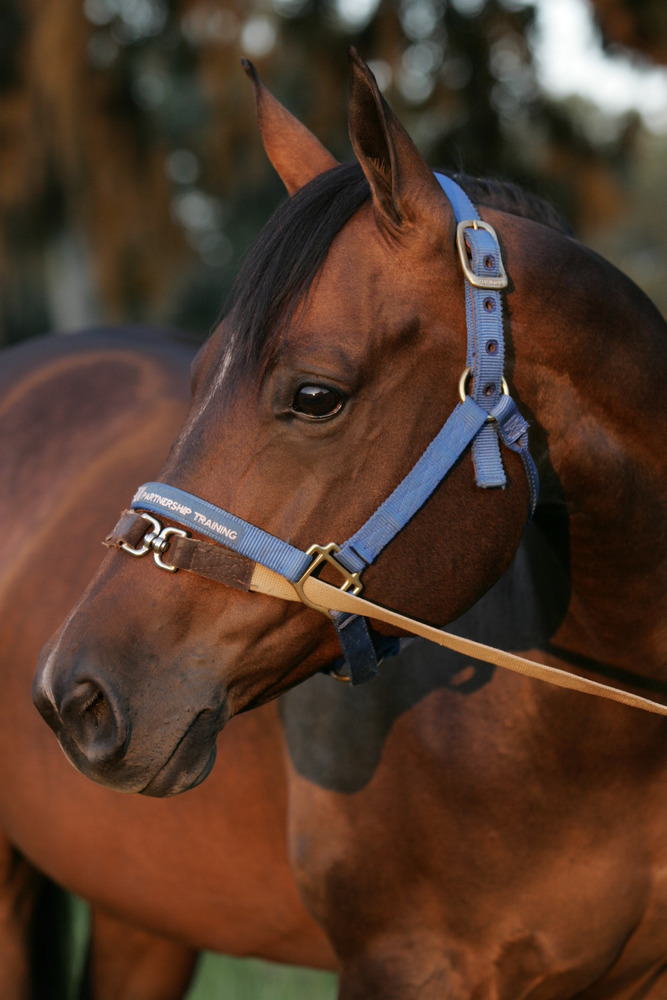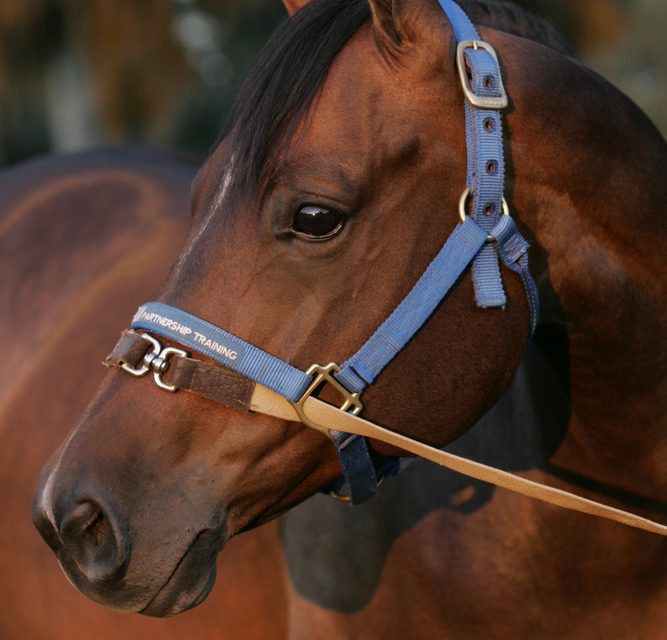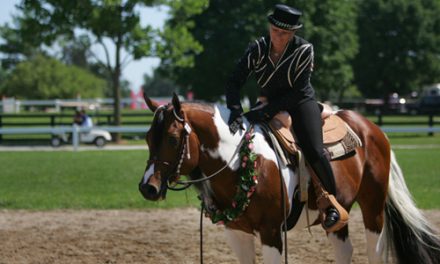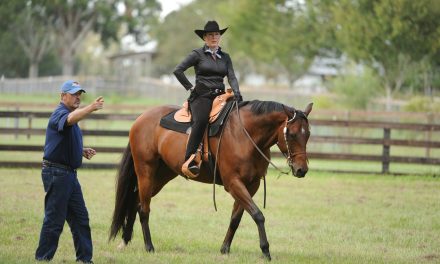Palm Partnership Training™
Building a Partnership with Your Horse“Ponying Your Horse, Part 1

I am going to share a different technique for working your horse in hand. It is called “ponying” and means leading one horse from another horse that you are mounted on. Some of the benefits of ponying include:
- It is an excellent conditioning exercise for young horses that have not been started under saddle
- It allows a young or spooky horse to learn from a older horse to accept new surroundings
- It makes a horse that has difficulty being near another horse learn to be more sociable
- It gives you another training and conditioning tool to use to keep your horse from getting bored with the same daily training and exercising routines.
To keep things straight, I’ll refer to the horse being lead or “ponyed” as the “pony horse”. Usually this will be a youngster, but it can be an older horse that needs some re-schooling. The horse that you will be mounted to lead the pony horse is the “lead” horse. I will describe this exercise as if leading the pony horse from the off (right) side of my lead horse.
Always begin ponying in an enclosed fenced area, such as a paddock, in case the pony horse would get away from you.
For this lesson you will need a flat cotton longe line with a short chain end.
Equip the pony horse with a properly fitting halter and thread the longe line through the halter’s side ring, over the nose, and snap it to the side ring on the opposite side of the halter. Put leg protection on him such as polo wraps. Have a helper hold the pony horse away from the lead horse until you are mounted and in position.
Choose a lead horse that is a more experienced, seasoned mount. When ponying, I suggest using western saddle on the lead horse because the horn can give the rider more security. Hold both reins in one hand and make sure to keep your hands positioned in front of the saddle. If using split reins, cross one rein over and hold them one on top of the other.
We will start by tracking to the left. Mount up on the lead horse and position yourself parallel to the paddock’s fence. Stay far enough away to leave enough space for the pony horse to stand between the lead horse and the fence. Ask the helper to bring the pony horse behind the lead horse and into position so the pony horse is between the lead horse and the fence. Keep at least one horse width space between the lead horse and the pony horse.
Take the longe line from the helper and hold it in a neatly stacked coil in your right hand. The longe line loops should be roughly the same length. I like to keep my index finger and my thumb between the last loop leading out to the pony horse. That lets me use my fingers to take up a little on the longe line if needed, or give out more line.
Give the pony horse and the lead horse a few moments to touch noses and greet each other so that they will not be afraid of one another. The pony horse, especially if he is a youngster, may be a little apprehensive of having something like the longe line in your hand over the top of his head. This is one of the benefits of ponying: getting a horse to accept something over his head. Before starting, reach over and pet and touch the pony horse. This will further accustom him to something being over this head and reassure him.
The pony horse needs to keep his space from the lead horse and his body straight. I will use a light tug on the longe to keep his head straight if he looks to the outside. If the pony horse comes in too close I encourage him to stay out by swinging the longe line coil with my right arm alongside the lead horse. This gives the pony horse a visual cue to move away. If I need to move the pony horse even further away, I will toss or shake the longe line coil towards him.
Practice both of these “move away” techniques while standing alongside the fence to make sure the pony horse is not afraid of the movement of the longe line before proceeding.
Your Next Step…
You are mounted on the lead horse with the pony horse alongside. The pony horse understands your gestures with the longe line to move away. Now you are ready to begin ponying.
Stay in position with the pony horse alongside the fence. Ask the lead horse to WALK forward, using your voice and seat/leg aids, as you extend your arm to encourage the pony horse to walk with you. Ask the helper to walk alongside the pony horse when you are first starting and be ready to help out if he gets confused or startled.
Your goal should be to keep the pony horse’s head between the lead horse’s neck and your leg. If he gets behind your leg, he is too far back. If he gets far in front of the lead horse’s neck, he is too far forward. Keep the lead horse moving at the speed of the pony horse—and not the other way around. Encourage the pony horse to stay straight using the techniques I described above.
Walk forward a short distance then ask the lead horse to WHOA using voice and seat/leg aids. The pony horse should respond to your voice command and the action of the lead horse and stop. Watch to maintain the space between the horses as you stop.
Continue working alongside the fence to the left and try different changes in maneuvers between walk, stop, back, and whoa. If the pony horse is responding well move off the fence and repeat these maneuvers to the left. Evaluate how well he stays straight without the security of the fence to guide him. If you need to, go back to working alongside the fence until he understands to stay straight.
Ponying through a turn to the right offers another set of challenges. To change directions and steer the pony horse to the right, you will need to increase the speed with the lead horse since he will be on the outside of the turn and decrease the speed of the pony horse. If you do not keep your lead horse forward enough and up with the pony horse, the pony horse will be turning his head into the lead horse all the time.
Try a turn to the right at the walk first. As you turn to the right, swing the longe line between the horses or “toss” it gently toward the pony horse to get him to turn away from the lead horse as you turn toward the right.
Evaluate the pony horse’s acceptance of ponying by testing him through a series of turns in both directions, stopping, backing, and changing directions at the walk. In the next article, we will discuss how as our pony horse shows he understands what we are asking him to do at the walk, we will move on to teaching him to pony at the trot. The pony horse must be able to do these basic maneuvers at the walk and trot, both to the right and left, before we can graduate to ponying him outside of the paddock.
Until then, follow your dreams…
For more information about Lynn Palm; her educational programs at Palm Equestrian Academy in Ocala, Florida; Lynn’s Ride Well clinics across the U.S.; saddles; DVDs; books; and trail and Western dressage competitions; visit www.lynnpalm.com or call 352/629-3310.




